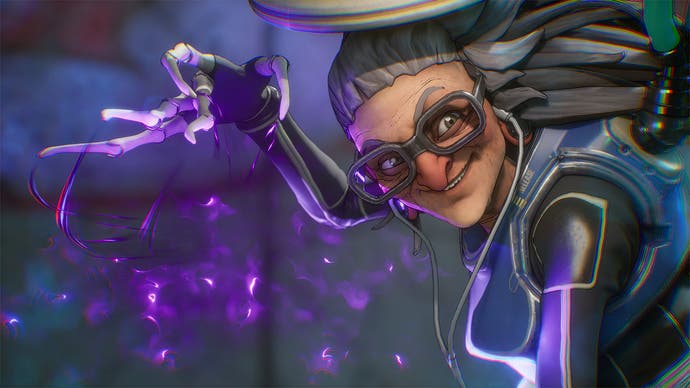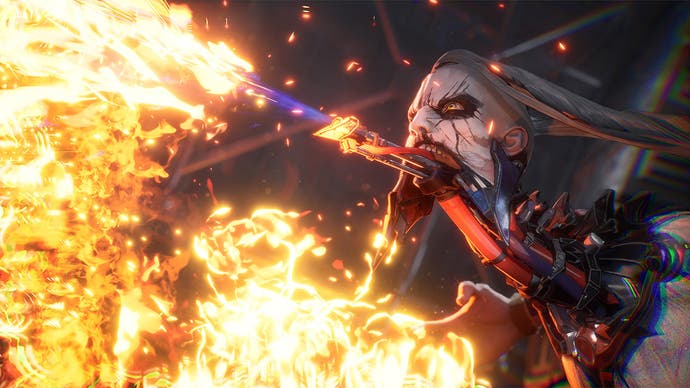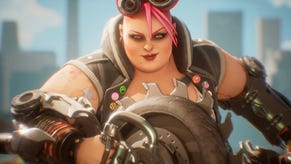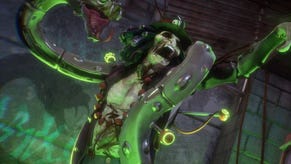Bleeding Edge is maybe a misnomer, but Ninja Theory is rightfully bullish
Why multiplayer? "Because I'm the creative director and I like it."
Honestly, I went into my hands-on with Bleeding Edge thinking there was more than a little whiff of Lawbreakers about it - and you can't really blame me. Here we have a well-known developer going all class-based-multiplayer-action-team-based et cetera et cetera. Especially, too, as it's been so long since Overwatch first carved out that little corner of the market, and so clear that most of the plucky, edgy-haircutted challengers that tried to go toe-to-toe - Lawbreakers yes, plus Battleborn, Drawn to Death, Paragon and the rest - have largely fallen by the wayside.
I'm relieved to say I am at least not underwhelmed by it - in fact I am positively whelmed - because there is thankfully quite a bit more to Bleeding Edge than the edgy haircuts and all that usual stuff. The game modes seem fairly run-of-the-mill - a small arena with three capture points on it was what I played, the points periodically opening and closing being a simple twist - but the combat is surprisingly deep.
You have a stamina gauge - three bars, different things using different amounts - that paces your abilities. You have three abilities with their own cooldowns. You have a choice of two ultimates. And you have a hoverboard. (There's also a system of mods we couldn't dig into, but their effects are displayed on the killscreen if you get taken out - plus X amount of Y, and the like - that could be a great little addition).

There is, also, a noticeable chunk of Devil May Cry in there - at least in the sense you can mash out a satisfying melee combo or, if you're feeling swish, jump and mash out a satisfying combo (can you tell DMC isn't really my jam?). It feels tight and responsive, which is critical, because the melee twist is the main thing separating Bleeding Edge from the rest, but most of all there are clear signs of synergy there, that sweet holy grail of team-based design that's much harder to tap into than you'd expect.
I played an assassin class (there are three: assassins, supports, and tanks - standard), with a nice little set of tools, including slowing shuriken, a seemingly unending invisibility skill that only stops when you attack and allows to you sleep opponents until they take damage, and a flashy dash. It tied in nicely with a Mercy-style healer class keeping me topped up as I dove into the other team's backline, it faltered when I lost my support and went awry when I tried to be a hero and went solo.
If you've played any of these games before that's all very familiar, still. It's good and bad - Bleeding Edge works, it feels great, and it has one or two tricks up its sleeve - it also works the same as most others in the genre, feels as good as they feel (or felt), and its tricks aren't, really, that revolutionary.
Another time-will-tell job then, as any game of its kind will be, at this point. At the very least, there's a cracking team behind it with a hell of a pedigree in tasty melee action. After playing a round I managed to grab a few minutes with Rahni Tucker, creative director at Ninja Theory who's leading the way on Bleeding Edge - she's refreshingly blunt and pleasantly bullish.

So, the obvious one, why the surprise switch to multiplayer for Ninja Theory?
Rahni Tucker: Mostly because, I'm the creative director I think, and I like it? (laughs). It's as simple as that. You know Hellblade's Tameem [Antoniades, Ninja Theory boss]'s game that's his stuff, that's what he does really well, and then when I got the opportunity to start a project it was about combining my passion, so it's third-person action-combat - because I did the combat of DmC I wanted to do more of that, I liked making it - it's the thing I like to make. And then like I mentioned in the briefing, I like to play competitive team games, so I really wanted to make a multiplayer game and it was like [heavenly sound] there is this game right? (laughs)
I noticed during the briefing you seemed to make a point of saying this had been in development since before Microsoft came along and brought Ninja Theory on board - was that something you mentioned deliberately, because you were maybe worried with how fans might react to the switch to multiplayer from something like Hellblade? Like they might have assumed it was Microsoft making you do that?
Rahni Tucker: Oh my god if we could make that [much progress on Bleeding Edge] in a year then that'd be amazing (laughs). I don't know, did I mention that? I don't know if I did? I don't know if I really thought about it that much? [For reference it was actually Tucker's Ninja Theory colleague, Dom Matthews, speaking alongside Tucker].
So you weren't consciously going "don't worry guys"...
Rahni Tucker: No I mean, I think yeah Tameem's back there doing his thing, so for people that are fans of Ninja Theory and want to see that kind of stuff, it's like, Tameem's got them covered.
Do you know if the interest from Microsoft was because of the fact you were planning on doing a multiplayer game?
Rahni Tucker: I can't really speak to that because I wasn't really part of the whole thing, that was kind of board of directors stuff. But I don't believe so.
You mentioned the fact Tameem's got something he's working on as well, have you got any kind of message for fans who're in need of reassurance that the single-player narrative stuff is still coming?
Rahni Tucker: Erm, not really I can't really speak to that, unfortunately. I just don't know, I'm just here, that's my game, that's all I focus on, I'm on my side of the office doing my thing! (laughs)
Has Ninja Theory had to expand quite quickly to go for this kind of game - obviously it must have been in development for a little while, but moving to a kind of service game that's going to be live for a long time, has there had to be a fairly rapid expansion there?
Rahni Tucker: Not really, we had to bolster the team a little bit, but most of the bolstering came internally, there's been an average of around 15 people on the project, so similar size to what you've been talking about with Hellblade, but now there's maybe 25 people on the team? So it's a little bit bigger, prepping for stuff like customer support and the infrastructure that you need around having a live game. But nothing crazy, no - we haven't done like, major expansion.
And sticking with Bleeding Edge, there's quite an aesthetic to it - and noticeably a really diverse roster of characters, which I think is great. Was that a conscious thing you were going for?
Rahni Tucker: No it just sort of happened. The main thing was we just wanted all the characters to feel aspirational, cool, badass, you know have a lot of character so that when you see them in the game, they represent who they are and they're really identifiable - so making sure they've got a good silhouette, and they read well with their animation, they're full of personality. We need them to be able to tell their story about who they are about how they behave and what they look like.
Is there going to be some kind of element in the game, or out of it maybe in that sort of Overwatch cinematic style of doing things, where we see a bit more about the characters and what they're about?
Rahni Tucker: I mean right now for the technical alpha we're focusing on the gameplay because that's the most important thing, to tune that and work with the players to get that awesome. There's definitely like a lot of rich backstory there to work with, but we'll see what happens.
You mentioned the kind of DmC-style combat, is that an audience you're aiming for? I know you said that's your own personal taste too, are you consciously aiming for a kind of Devil May Cry feel to it?
Rahni Tucker: Not particularly - and I think actually if you go into the game trying to play it like DmC you'll probably get annihilated (laughs). Because it's very much a team game, so it's more about taking the sensibilities that I learnt there, about how to make the combat feel nice, feel responsive, look cool, that's coming into Bleeding Edge, as opposed to wanting to make a game exactly like that for multiplayer.
Are you confident the melee combat aspect to it is enough to make it stand out in a pretty crowded genre, that has some pretty big games already dominating it?
Rahni Tucker: Yeah. I think that it is. I think that when people play the game they kind of get it. They get their hands on it and they're locking onto characters, dodging attacks, doing combos, dropping specials, comboing with friends, working as a team. I think the game kind of comes together in the playing of it.
And on DmC as well - how do you personally feel about Devil May Cry 5 having moved on from DmC at Ninja Theory. I know DmC: Devil May Cry was quite different to the usual formula and suffered a little having already been quite pre-judged at the time. Do you feel there's been any kind of capitulation to fans with Capcom going back to the usual formula with DMC5 and sweeping DmC under the carpet, or that your vision was undercut a bit?
Rahni Tucker: Not at all, I think the game's awesome (laughs). I've played it, I haven't finished it, I'm very close to the end and I'm annoyed that I haven't got a chance to finish it yet but, I love V.
Finally, how do you plan on monetising and supporting Bleeding Edge over time, it being an ongoing service game?
Rahni Tucker: Right now, there are no in-game purchases of any kind. You can earn everything through gameplay. We will definitely never sell anything that will affect the balance of the game, so like heroes - and there's a mod system in the game, that you can use to kind of slightly tweak the way that your character plays, and we won't sell those. And obviously we want to keep supporting the game with new content, new features, through technical alpha and beyond from launch as well.






